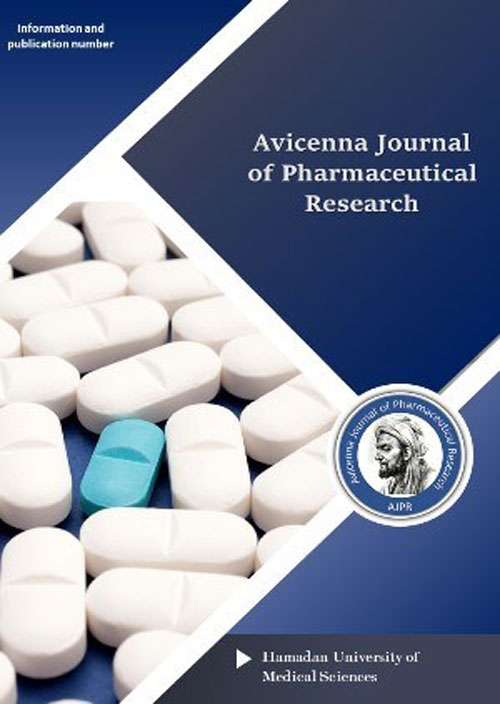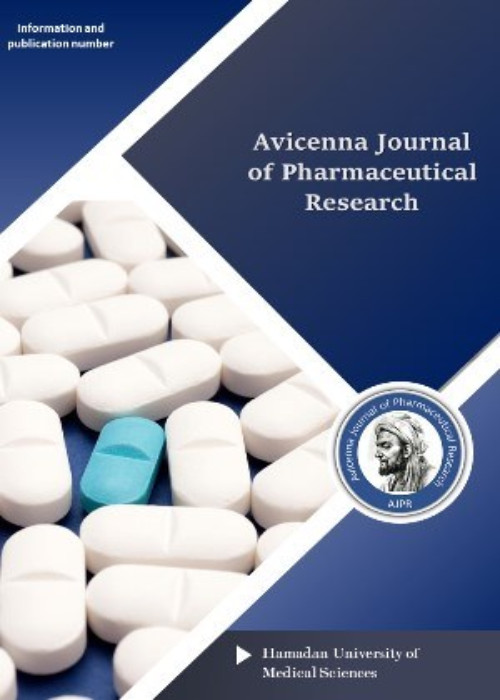فهرست مطالب

Avicenna Journal of Pharmaceutical Research
Volume:2 Issue: 2, Dec 2021
- تاریخ انتشار: 1401/05/15
- تعداد عناوین: 8
-
Pages 44-48Background
Gadolinium compounds are used as contrast enhancers in MRI imaging. Generally, free metal ions are not used in MRI imaging due to their toxicity. To reduce the toxicity of the free form of the metal, complexing agents are employed for making nanoparticles. Due to their low toxicity and natural abundance, plant extracts having potential to function as chelating agents are good alternatives for the formation of gadolinium nanoparticles.
MethodsAqueous extracts of five plant species, including Thymus daenensis Celak, Nepeta sessilifolia Bung, Crocus sativus L., Salvia hydrangea DC. ex Benth, and Hymenocrater incanus Bunge were prepared. Five complexes were produced as the result of each extract’s reaction with gadolinium nitrate solution in the presence of 1 mM solution of NaOH. The obtained complexes were analyzed adopting the Fourier transform infrared spectroscopy (FTIR), scanning electron microscopy (SEM), and Energy dispersive x-ray analysis (EDAX) techniques.
ResultsEDAX analysis of the obtained complexes confirmed the presence of gadolinium in all complexes. Among the five complexes, the highest percentage of gadolinium (21.07) was recorded for the complex derived from the extract of H. incanus Bunge, while the lowest one (9.33) was detected for the complex derived from the T. daenensis Celak. Despite adopting various methods to disperse the complex particles in deionized water in order for determining the particle size, the high adhesion of the particles prevented the determination of the desired particle size in nanoscale.
ConclusionAlthough synthesizing the complexes was successful and EDAX confirmed the presence of gadolinium metal in them, SEM analysis failed to prove their nanoparticle structure. The high tendency of solid particles to adhere was found to prevent the formation of independent nanoparticles in solution.
Keywords: Gadolinium complexes, Medicinal plants, Extract, MRI imaging -
Pages 49-54Background
Plantago species have been used in traditional medicine to treat many types of diseases. The detection of apigenin, catalpol, and gallic acid in Plantago lanceolata and Plantago major has been optimized using this protocol.
MethodsThe analyses were optimized using the C8 column, acetonitrile, and orthophosphoric acid–water (1:1%) as mobile phase at a flow rate of 1 mL.min-1, and a wavelength detector was observed at λ 204 nm.
ResultsThe limits of detection (LOD) and quantification (LOQ) of the method were "0.04 and 0.14 μg/ mL", "0.007 and 0.022 μg/mL", as well as "0.02 and 0.073 μg/mL" for catalpol, apigenin, and gallic acid, respectively. The highest level of apigenin in the dry weight of plants (4.34, and 1.99 μg/mg) was obtained from the spike and aerial parts of P. lanceolata and P. major species. High levels of gallic acid extracted from aerial parts and leaves of both species were 12.85 and 10.11 μg/mg, respectively. The highest amount of catalpol (43.33 and 18.15 μg/mg DW) was obtained from the spike of both Plantago sp. The calibration curves were linear with a correlation coefficient (r>0.9991, 0.9996, and 0.9978).
ConclusionIn sum, the most simple and sensitive method to measure compounds was developed using HPLC, which showed a great validity.
Keywords: Gadolinium complexes, Medicinal plants, Extract, MRI imaging -
Pages 55-59Background
Drug utilization evaluation (DUE) was performed to assess using drugs with special conditions such as antibiotics. Vancomycin is one of the essential antibiotics that is effective on methicillin-resistant Staphylococcus aureus, but unreasonable use of vancomycin, in addition to cost, leads to outbreak microbial resistance, which is a concern for health care systems all around the world. The aim of this study was to evaluate vancomycin use in teaching hospitals in Hamedan, Iran.
MethodsThis retrospective study was performed on patients who received vancomycin for at least 72 hours in intensive care units and infectious wards between April and September 2020 in the teaching hospitals of Hamedan. Data were obtained from patients’ medical records and entered into predesigned checklists.
ResultsFrom 661 patients, 441 were males and 247 were females. They received vancomycin for an average of 5.75 days. The most prevalent indication for vancomycin use was surgery. Only 40 patients had sensitive microbial culture to vancomycin, while 356 of them (53.9%) had no microbial culture at all. According to HICPAC guidelines, the overall appropriate use of vancomycin was 44.8%.
ConclusionAccording to the results, the irrational use of vancomycin must be corrected to achieve maximum optimal use; thus, performing and adhering to microbial culture, deploying clinical pharmacists, and holding explanatory sessions for health care are recommended for this purpose.
Keywords: Drug Utilization Evaluation, Vancomycin, Microbial culture, HICPAC guidelines -
Pages 60-65Background
Drug-drug interactions can often lead to preventable adverse drug events and hospitalization. However, the clinical outcome of a potential drug-drug interaction that may range from minor alterations to major toxicity or loss of effect is often unknown. Drugs with narrow therapeutic index are more susceptible to the outcomes of interactions. Anticoagulants are one of the drug groups prone to drug-drug interactions and have important side effects. in this retrospective study, the frequency of drug-drug interactions involving warfarin, heparin and enoxaparin was investigated.
MethodsOverall, 300 patients (including 55% males with an average age of 50.75 years) participated in this study, and for each anticoagulant, 100 patient orders were randomly selected from the hospital system. Drug-drug interactions were evaluated using the Micromedex drug interaction checker.
ResultsA total of 1691 drug-drug interactions (306 major, 253 moderate, and 89 minor interactions) were recorded of which only 648 (average 2.16) involved warfarin, heparin, or enoxaparin. Most interactions were recorded in patients admitted to the cardiovascular surgery (n=312) and cardiology (n=119) wards. There was a significant relationship between the number of drugs and the frequency of interaction. warfarin had the highest number of interactions (n=388).
ConclusionThe frequency of drug interactions is high in patients on anticoagulant therapy. The efficacy and safety of these drugs can be affected by drug interactions. Accordingly, these interactions should always be considered, especially in patients with multiple drug use. Efficient monitoring strategies should be employed to optimize treatment while reducing adverse effects.
Keywords: Drug-drug interactions, Warfarin, Enoxaparin, Heparin -
Pages 66-72Background
This cross-sectional descriptive study aimed to evaluate older adults or their caregivers’ attitudes and preferences toward ease of use and compliance of various dosage forms and to improve medication consumption in the elderly population.
MethodsThis research was conducted in 2021 using a validated questionnaire asking respondents about problems experienced through consuming various dosage forms, preferences regarding dosage forms and frequency, and demographics. The content validity index and content validity ratio were used in the validation evaluation.
ResultsThe incorrect medication in the elderly is mainly the result of forgetfulness. In addition, poor compliance was partly related to difficulty dividing tablets, large-sized drugs, and undesirable taste. Most elders preferred swelling pills and oral routes of administration. They further preferred to take fewer drugs in less-divided doses, just after a meal, at noon, or at bedtime. The child resistance packaging is unsuitable for them, and the blister or container with screw caps is preferred, and they adhere more to a medication when they are younger and more educated without relevance to gender or with whom they live.
ConclusionOur findings revealed that the formulation and administration of drugs according to elder preferences could improve their adherence to the medication.
Keywords: Compliance, Dosage forms, Elderly, Patients’ preferences -
Pages 73-78Background
The incidence of drug resistance against chemical antimicrobial drugs has directed the attention to the use of medicinal plants in the treatment of infections. This study aimed to evaluate the antimicrobial activity of Ficus carica extracts against pathogenic bacteria, especially nosocomial infections.
MethodsIn this experimental study, aqueous and alcoholic extracts of F. carica were extracted. This study investigated inhibitory effects of plant extracts against pathogenic bacteria such as Staphylococcus saprophyticus, Escherichia coli, Salmonella typhimurium, and Proteus mirabilis as well as pathogenic nosocomial including Staphylococcus aureus, Klebsiella pneumonia, Acinetobacter, and Pseudomonas aeruginosa through disk diffusion methods, well diffusion method, and microdilution. Serial dilutions of the extracts were prepared in the range of 50 to 1000 mg/mL to determine the minimum inhibitory concentration.
ResultsThe aqueous extract of the plant showed higher inhibitory effects against microbial strains compared to the alcoholic extract. The two strains of S. saprophyticus and S. aureus indicated greater susceptibility than extracts (e.g., aqueous, methanol, and ethanol). Statistically, there was a significant difference in the minimum inhibitory concentration of aqueous extract growth compared to alcoholic extracts. The aqueous extract had a minimum inhibitory concentration of 133 mg/mL and a minimum bactericidal concentration of 200 mg/mL on gram-positive bacteria of S. saprophyticus and S. aureus, respectively.
ConclusionThe study found F. carica that extract had significant effects on microorganisms of two gram-positive bacteria including S. saprophyticus (62 mm in diameter) and S. aureus (60 mm in diameter), and the bacterium P. aeruginosa revealed the highest resistance against gram-negative bacteria. The extracts also indicated significant effects compared to the antibiotics as a control. Although further research is needed in this regard, F. carica extract can be suggested as a new antimicrobial agent in medical research.
Keywords: Medicinal plant extract, Pathogenic bacteria, Minimum inhibitory concentration, Digestive andskin disease -
Pages 79-90
Diabetes is one of the major medical problems in the world. The discovery of insulin was a milestone in the history of medical science. This legendary invention has completed 100 years of its journey. Through this 100-year journey, many important events have taken place, and many modifications have been made to make it convenient for commercialization and patient compliance. After the antidiabetic activity of the pancreatic extract was discovered, the bovine and pork insulin came into use. Then, recombinant human insulin was discovered. Now long-acting to rapid-acting insulin forms are available (e.g., insulin pens, insulin pumps, and the like), and different systems are in use to deliver them to the body, but all these insulins are in invasive dosage forms and have some disadvantages, too. As we are using the oral form of most medicines, we prefer the oral form of insulin. Therefore, the concern is now to develop the oral dosage form of insulin. Some proposed oral dosage forms are at different stages of the clinical trial such as classical dosage forms, enzyme inhibitors, unnatural amino acids, nanoparticles, cell-penetrating peptides, and so on. Since the oral forms of insulin create some limitations and confusion, further research is required to solve these problems. Accordingly, the aim of the review was to predict the possibility of developing marketable oral insulin.
Keywords: Oral insulin, 100 years of insulin, Diabetes, Current forms of insulin, Pancreas, Recombinanttechnology -
Pages 91-98
In light of the widespread recognition of the heritability of hypertension (HTN), numerous studies have been conducted to better understand the pathogenesis of different variants of HTN and their interactions. The complexity of crucial HTN makes it difficult to segregate and identify particular genes that influence blood pressure (BP) fluctuation, making the development of single-gene targeted treatments tough. Therefore, finding HTN susceptibility genes will contribute to the understanding of the biology behind the disease. Apart from its potential impact on antihypertensive drug therapy selection, genomic information may also contribute to identifying persons at risk of developing the condition, resulting in new preventative strategies. It is necessary to conduct more replication studies in other populations to confirm that there is a link between certain genetic variations and the varying response to these frequently used antihypertensive medications. Moreover, antihypertensive medication responsiveness to epigenetics and regulatory networks may be improved by further research. This may aid researchers to find new HTN therapeutic targets. This study aimed to come up with a list of known genetic variants that may play a role in HTN.
Keywords: Hypertension, Genetics, Epigenetics, Pharmacogenomics, Heredity, Antihypertensivemedications, Therapeutic targets


